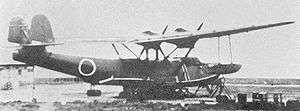Yokosuka H5Y
The Yokosuka H5Y (short designation) or Yokosuka Navy Type 99 Flying Boat Model 11 (九九式飛行艇, 99shiki hikōtei) (long designation), given the allied code name Cherry, was an IJNAS flying boat in service from 1938.
| H5Y | |
|---|---|
 | |
| Yokosuka H5Y Type 99 Flying Boat "Cherry" | |
| Role | Flying boat |
| Manufacturer | Yokosuka |
| First flight | 1936 |
| Introduction | 1939 |
| Primary user | Imperial Japanese Navy Air Service (IJNAS) |
| Produced | 1938 - 1941 |
| Number built | 20 |
Design and development
The H5Y was designed by Yokosuka to meet an IJNAS requirement for a twin-engine maritime reconnaissance flying boat, which was intended to match the performance of contemporary four-engine flying boats, while being cheaper to build and easier to maintain. Two prototypes were built at the 11th Naval Arsenal, Hiro, being completed in 1936.[1]
The H5Y was a twin-engine parasol wing aircraft, and thus resembled a scaled-down version of the Kawanishi H6K "Mavis". Performance was found to be poor however, with the aircraft underpowered and suffering from structural problems which delayed production. Only 20 were built between 1936 and 1941. Yokosuka Naval Air Arsenal built the aircraft at the Dai-Juichi Kaigun Kokusho facility.[1][2][3]
Operational history
The H5Y was accepted for production in 1938 as the Type 99 Flying Boat Model 11, production deliveries starting in 1939.[1] However, production was quickly cancelled owing to the poor performance, only 20 being built.[4] Although some were used for coastal anti-submarine patrols early in World War II, they were quickly transferred to second line duties such as transport or training.[1]
Variants
- H5Y
- 2 Prototypes constructed at the Hiro Naval Arsenal
- H5Y1
- Production model, 18 built.
- Yokosuka Navy Type 99 Flying Boat Model 11
- The long formal designation of the H5Y.
Specifications (Yokosuka H5Y1)
Data from Warplanes of the Second World War, Volume Five: Flying Boats[1]
General characteristics
- Crew: 6
- Length: 20.53 m (67 ft 4 in)
- Wingspan: 31.57 m (103 ft 7 in)
- Height: 6.71 m (22 ft 0 in)
- Wing area: 107.7 m2 (1,159 sq ft)
- Empty weight: 7,070 kg (15,587 lb)
- Gross weight: 11,500 kg (25,353 lb)
- Powerplant: 2 × Mitsubishi MK1A Shinten 21 14-cylinder air-cooled radial piston engines, 890 kW (1,200 hp) each
- Propellers: 3-bladed variable-pitch propellers
Performance
- Maximum speed: 306 km/h (190 mph, 165 kn) at 700 m (2,297 ft)[3]
- Range: 4,800 km (3,000 mi, 2,600 nmi)
- Endurance: 26 hours
- Service ceiling: 5,200 m (17,100 ft)
- Time to altitude: 3,000 m (9,843 ft) in 24 minutes
Armament
- Guns: 3× 7.7 mm (.303 in) machine guns
- Bombs: 2× 250 kg (552 lb) bombs
See also
Related lists
- List of aircraft of World War II
- List of flying boats
- List of military aircraft of Japan
References
- Notes
- Green 1972, pp. 136–137.
- Mikesh, Robert; Shorzoe, Abe (1990). Japanese Aircraft 1910–1941. London: Putnam. p. 262. ISBN 0-85177-840-2.
- Francillon, René J. (1979). Japanese Aircraft of the Pacific War. London: Putnam & Company Limited. p. 495. ISBN 0 370 30251 6.
- Donald 1997, p. ?.
- Bibliography
- Donald, David (Editor). The Encyclopedia of World Aircraft. Aerospace Publishing, 1997. ISBN 1-85605-375-X.
- Francillon, Ph.D., René J. Japanese Aircraft of the Pacific War. London: Putnam & Company Ltd., 1970 (2nd edition 1979). ISBN 0-370-30251-6.
- Green, William. Warplanes of the Second World War, Volume Five: Flying Boats. London: Macdonald & Co.(Publishers) Ltd., 1962 (5th impression 1972). ISBN 0-356-01449-5.
External links
| Wikimedia Commons has media related to Yokosuka H5Y. |